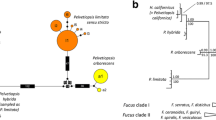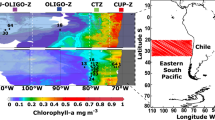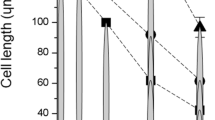Abstract
Protists thrive in polar oceans, where they represent a major driving force for globally important biogeochemical cycles and a key food-web component. Their biogeography is frequently associated to bipolar patterns of distribution. Although conceptually well supported by apparently unrestricted migration rates, the experimental certification of these patterns copes with the protist paucity of morphological characters with taxonomic value and difficulties in applying conventional species concepts. We studied three marine species of the ciliate Euplotes, E. euryhalinus, E. nobilii, and E. petzi, for their bipolar distribution by comparing the SSU-rRNA gene sequences and mating interactions of Antarctic, Patagonian, and Arctic strains. Each species was analogously found not to carry significantly varied SSU-rRNA gene sequences, implying a common occurrence of trans-equatorial genetic mixing. However, mating analyses revealed significant inter-species differences. Scarce Antarctic × Arctic strain mating compatibility distinguished E. petzi from E. euryhalinus and E. nobilii, in which mating pairs between Antarctic and Arctic strains were successfully induced. Yet, E. nobilii was the only one of the two species to show cross-fertilizing and fertile mating pairs. Taking the biological concept of species as discriminatory, it was thus concluded that only E. nobilii warrants the definition of genuine bipolar species.





Similar content being viewed by others
References
Achilles-Day, U. E. M., T. Pröschold & J. G. Day, 2008. Phylogenetic position of the freshwater ciliate Euplotes daidaleos within the family of Euplotidae, obtained from small subunit rDNA gene sequence. Denisia 23: 411–416.
Agatha, S., M. Spindler & N. Wilbert, 1993. Ciliated protozoa (Ciliophora) from Arctic sea ice. Acta Protozoologica 32: 261–268.
Alimenti, C., A. Vallesi, B. Pedrini, K. Wüthrich & P. Luporini, 2009. Molecular cold-adaptation: comparative analysis of two homologous families of psychrophilic and mesophilic signal proteins of the protozoan ciliate, Euplotes. IUBMB Life 61: 838–845.
Armbrust, E. V., 2009. The life of the diatoms in the world’s oceans. Nature 459: 185–192.
Candelori, A., P. Luporini, C. Alimenti & A. Vallesi, 2013. Characterization and expression of the gene encoding En-MAPK1, an intestinal cell kinase (ICK)-like kinase activated by the autocrine pheromone-signaling loop in the polar ciliate, Euplotes nobilii. International Journal of Molecular Sciences 14: 7457–7467.
Chen, X., Y. Zhao, S. A. Al-Farraj, S. A. Al-Quraishy, H. A. El-Serehy, C. Shao & K. A. S. Al-Rasheid, 2013. Taxonomic descriptions of two marine ciliates, Euplotes dammamensis n. sp. and Euplotes balteatus (Dujardin, 1841) Kahl, 1932 (Ciliophora Spirotrichea, Euplotida), collected from the Arabian Gulf, Saudi Arabia. Acta Protozoologica 52: 73–89.
Chiappori, F., S. Pucciarelli, I. Merelli, P. Ballarini, C. Miceli & L. Milanesi, 2012. Structural thermal adaptation of β-tubulins from the Antarctic psychrophilic protozoan Euplotes focardii. Proteins 80: 1154–1166.
Darling, K. F. & C. M. Wade, 2008. The genetic diversity of planktic foraminifera and the global distribution of ribosomal RNA genotypes. Marine Micropaleontology 67: 216–238.
Darling, K. F., C. M. Wade, I. A. Steward, D. Kroon, R. Dingle & A. J. Leigh Brown, 2000. Molecular evidence for genetic mixing of Arctic and Antarctic subpolar populations of planktonic foraminifers. Nature 405: 43–47.
de Vargas, C., L. Zaninetti, H. Hilbrecht & J. Pawlowski, 1997. Phylogeny and rates of molecular evolution of planktonic foraminifera: SSU rDNA sequences compared to fossil records. Journal of Molecular Evolution 45: 285–294.
Di Giuseppe, G., M. Barbieri, A. Vallesi, P. Luporini & F. Dini, 2013a. Phylogeographical pattern of Euplotes nobilii, a protist ciliate with a bipolar biogeographical distribution. Molecular Ecology 22: 4029–4037.
Di Giuseppe, G., F. Dini, C. Alimenti, A. Vallesi & P. Luporini, 2013b. Pole to pole gene flow in protozoan ciliates. In Di Prisco, G. & C. Verde (eds), Adaptation and Evolution in Marine Environments, Vol. 2. Springer, Berlin: 55–66.
Di Giuseppe, G., F. Erra, F. Dini, A. Alimenti, A. Vallesi, B. Pedrini, K. Wüthrich & P. Luporini, 2011. Antarctic and Arctic populations of the ciliate Euplotes nobilii show common pheromone mediated cell-cell signaling and cross-mating. Proceedings of the National Academy of Sciences of the United States of America 108: 3181–3186.
Di Giuseppe, G., F. Erra, F. P. Frontini, F. Dini, A. Vallesi & P. Luporini, 2014. Improved description of the bipolar ciliate, Euplotes petzi, and definition of its basal position in the Euplotes phylogenetic tree. European Journal of Protistology 50: 402–411.
Dini, F. & D. Nyberg, 1993. Sex in ciliates. In Jones, J. G. (ed.), Advances in Microbial Ecology. Plenum Press, New York: 85–153.
Dolan, J. R., E. J. Yang, S. H. Lee & S. Y. Kim, 2013. Tintinnid ciliates of Amundsen Sea (Antarctica) plankton communities. Polar Research 32: 19784.
Ehrenberg, C. G., 1844. Einige vorläufige Resultate seiner Untersuchungen der ihm von der Südpol reise des Captain Ross, so wie von den Herren Schayer und Darwin zugekommenen Materialien über das Verhalten des kleinsten Lebens in den Oceanen und den grössten bisher zugänglichen Tiefen des Weltmeeres. Bericht über die zur Bekanntmachung Geeigneten Verhandlungen Der Königl. Preuss. Akademie Der Wissenschaften zu Berlin 1844: 182–207
Falkowski, P. G., M. E. Katz, A. H. Knoll, A. Quigg, J. A. Raven, O. Schofield & F. J. R. Taylor, 2008. The evolution of modern eukaryotic phytoplankton. Science 305: 354–360.
Felsenstein, J., 1988. Phylogenies from molecular sequences: inference and reliability. Annual Review of Genetics 22: 521–565.
Fensome, R. A., R. A. MacRae, J. M. Moldowan, F. J. R. Taylor & G. L. Williams, 1996. The early Mesozoic radiation of dinoflagellates. Paleobiology 22: 329–338.
Finkelstein, S. A., J. Bunbury, K. Gajewski, A. P. Wolfe, J. K. Adams & J. E. Devlin, 2014. Evaluating diatom-derived Holocene pH reconstructions for Arctic lakes using an expanded 171-lake training set. Journal of Quaternary Science 29: 249–260.
Génermont, J., V. Machelon & M. Tuffrau, 1976. Données expérimentales relatives au problème de l’espèce dans le genre Euplotes (Ciliés hypotriches). Protistologica 12: 239–248.
Geralt, M., C. Alimenti, A. Vallesi, P. Luporini & K. Wüthrich, 2013. Thermodynamic stability of psychrophilic and mesophilic pheromones of the protozoan ciliate Euplotes. Biology 2: 142–150.
Gersonde, R., 1990. The paleontological significance of fossil diatoms from high latitude oceans. In Medlin, L. K. & J. Priddle (eds), Polar Marine Diatoms. British Antarctic Survey, Cambridge: 57–63.
Hall, T. A., 1999. BioEdit: a user-friendly biological sequence alignment editor and analysis program for Windows 95/98/NT. Nucleic Acids Symposium 41: 95–98.
Jiang, J., Q. Zhang, X. Hu, C. Shao, K. A. S. Al-Rasheid & W. Song, 2010a. Two new marine ciliates, Euplotes sinicus sp. nov. and Euplotes parabalteatus sp. nov., and a new small subunit rRNA gene sequence of Euplotes rariseta (Ciliophora, Spirotrichea, Euplotida). International Journal of Systematic and Evolutionary Microbiology 60: 1241–1251.
Jiang, J., Q. Zhang, A. Warren, K. A. S. Al-Rasheid & W. Song, 2010b. Morphology and SSU rRNA gene-based phylogeny of two marine Euplotes species, E. orientalis spec. nov. and E. raikovi Agamaliev, 1966 (Ciliophora, Euplotida). European Journal of Protistology 46: 121–132.
Kepner Jr, R. L., R. A. Jr Wharton & D. W. Coats, 1999. Ciliated protozoa of two Antarctic lakes: analysis by quantitative protargol staining and examination of artificial substrates. Polar Biology 21: 285–294.
Knox, G., 1994. The Biology of Southern Ocean. Cambridge University Press, Cambridge.
Lovejoy, C., 2014. Changing views of Arctic protists (marine microbial eukaryotes) in a changing Arctic. Acta Protozoologica 53: 91–100.
Lovejoy, C., R. Massana & C. Pedros-Alio, 2006. Diversity and distribution of marine microbial eukaryotes in the Arctic Ocean and adjacent seas. Applied and Environmental Microbiology 72: 3085–3095.
Medlin, L., H. J. Elwood, S. Stickel & M. L. Sogin, 1988. The characterization of enzymatically amplified eukaryotic 16S-liker RNA-coding regions. Gene 71: 491–499.
Mieczan, T., D. Gorniek, A. Swiatecki, M. Zdanowski & M. Tarkowska-Kukuryk, 2013. The distribution of ciliates on Ecology Glacier (King George Island, Antarctica): relationships between species assemblages and environmental parameters. Polar Biology 36: 249–258.
Montresor, M., C. Lovejoy, L. Orsini, G. Procaccini & S. Roy, 2003. Bipolar distribution of the cyst-forming dinoflagellate Polarella glacialis. Polar Biology 26: 186–194.
Nobili, R., P. Luporini & F. Dini, 1978. Breeding systems, species relationships and evolutionary trends in some marine species of Euplotidae. In Battaglia, B. & J. A. Beardmore (eds), Marine Organisms: Genetics, Eecology and Evolution. Plenum Press, New York: 591–616.
Pawlowski, J., J. Fahrni, B. Lecroq, D. Longet, N. Cornelius, L. Excoffier, T. Cedhagen & A. J. Gooday, 2007. Bipolar gene flow in deep-sea benthic foraminifera. Molecular Ecology 16: 4089–4096.
Pedrini, B., W. J. Placzek, E. Koculi, C. Alimenti, A. La Terza, P. Luporini & K. Wüthrich, 2007. Cold-adaptation in sea-water-borne signal proteins: sequence and NMR structure of the pheromone En-6 from the Antarctic ciliate Euplotes nobilii. Journal of Molecular Biology 372: 277–286.
Petroni, G., F. Dini, F. Verni & G. Rosati, 2002. A molecular approach to the tangled intrageneric relationships underlying phylogeny in Euplotes (Ciliophora, Spirotrichea). Molecular Phylogenetics and Evolution 22: 118–130.
Petz, W., 2004. Ciliate biodiversity in Antarctic and Arctic freshwater habitats – a bipolar comparison. European Journal of Protistology 39: 491–494.
Petz, W., 2005. Ciliates. In Scott, F. J. & H. J. Marchant (eds), Antarctic Marine Protists. Australian Biological Resources Study, Camberra: 347–448.
Petz, W. & W. Foissner, 1997. Morphology and infraciliature of some soil ciliates (Protozoa, Ciliophora) from continental Antarctica, with notes on the morphogenesis of Sterkiella histriomuscorum. Polar Records 33: 307–326.
Petz, W., W. Song & N. Wilbert, 1995. Taxonomy and ecology of the ciliate fauna (Protozoa, Ciliophora) in the endopagial and pelagial of the Weddel Sea, Antarctica. Stapfia 40: 1–223.
Petz, W., A. Valbonesi, U. Schiftner, A. Quesada & C. Ellis-Evans, 2007. Ciliate biogeography in Antarctic and Arctic freshwater ecosystems: endemism or global distribution of species? FEMS Microbial Ecology 59: 396–408.
Posada, D. & K. A. Crandall, 1998. MODELTEST: testing the model of DNA substitution. Bioinformatics 14: 817–818.
Ronquist, F. & J. P. Huelsenbeck, 2003. MrBayes 3: Bayesian phylogenetic inference under mixed models. Bioinformatics 19: 1572–1574.
Schmidt, H. A., K. Strimmer, M. Vingron & A. von Haeseler, 2002. TREE-PUZZLE: maximum likelihood phylogenetic analysis using quartets and parallel computing. Bioinformatics 18: 502–504.
Scott, F. J. & H. J. Marchant, 2005. Antarctic Marine Protists. Australian Biological Resources Study, Camberra.
Sims, P. A., D. G. Mann & L. K. Medlin, 2006. Evolution of the diatoms: insights from fossil, biological and molecular data. Phycologia 45: 361–402.
Sorokin, Y. I., 1999. Aquatic Marine Ecology. Backhuys, Leiden.
Souffreau, C., H. Verbruggen, A. P. Wolfe, P. Vanormelingen, P. A. Siver, E. J. Cox, D. G. Mann, B. Van de Vijver, K. Sabbe & W. Vyverman, 2011. A time-calibrated multi-gene phylogeny of the diatom genus Pinnularia. Molecular Phylogenetics and Evolution 61: 866–879.
Swofford, D. L., 2003. PAUP*: Phylogenetic Analysis Using Parsimony (*and Other Methods). Sinauer Associates, Sunderland, Massachusetts.
Taylor, F. J. R., M. Hoppenrath & J. F. Soldiarrage, 2008. Dinoflagellate diversity and distribution. Biodiversity Conservation 17: 407–418.
Thompson, J. D., T. J. Gibson, F. Plewniak, F. Jeanmougin & D. G. Higgins, 1997. The ClustalX windows interface: flexible strategies for multiple sequence alignment aided by quality analysis tools. Nucleic Acids Research 4: 4876–4882.
Valbonesi, A. & P. Luporini, 1990a. Description of two new species of Euplotes (Ciliophora, Hypotrichida) from Antarctica. Polar Biology 11: 47–53.
Valbonesi, A. & P. Luporini, 1990b. A new marine species of Euplotes (Ciliophora, Hypotrichida) from Antarctica. Bulletin of the British Museum of Natural History (Zoology) 56: 57–61.
Valbonesi, A. & P. Luporini, 1993. Biology of Euplotes focardii, an Antarctic ciliate. Polar Biology 13: 489–493.
Valbonesi, A., C. Ortenzi & P. Luporini, 1992. The species problem in a ciliate with a high multiple mating type system, Euplotes crassus. Journal of Protozoology 39: 45–54.
Vallesi, A., C. Alimenti, G. Di Giuseppe, F. Dini & P. Luporini, 2012. Coding genes and molecular structures of the diffusible signaling proteins (pheromones) of the polar ciliate, Euplotes nobilii. Marine Genomics 8: 9–13.
Vallesi, A., C. Alimenti, G. Di Giuseppe, F. Dini, B. Pedrini, K. Wüthrich & P. Luporini, 2010. The water-born protein pheromones of the polar protozoan ciliate, Euplotes nobilii: coding genes and molecular structures. Polar Science 4: 237–244.
Vincent, W. F., 1988. Microbial Ecosystems of Antarctica. Cambridge University Press, Cambridge.
Wilbert, N. & W. Song, 2005. New contributions to the marine benthic ciliates from the Antarctic area, including description of seven new species (Protozoa, Ciliophora). Journal of Natural History 39: 935–973.
Wilbert, N. & W. Song, 2008. A further study on littoral ciliates (Protozoa, Ciliophora) near King George Island, Antarctica, with description of a new genus and seven new species. Journal of Natural History 42: 979–1012.
Acknowledgments
The authors warmly thank anonymous reviewers for insightful and constructive criticisms, and Dr. Gill Philip for editing the English usage. The research was financially supported by the “Programma Nazionale di Ricerca in Antartide” (PNRA).
Author information
Authors and Affiliations
Corresponding author
Additional information
Guest editors: Diego Fontaneto & Stefano Schiaparelli / Biology of the Ross Sea and Surrounding Areas in Antarctica
Rights and permissions
About this article
Cite this article
Di Giuseppe, G., Dini, F., Vallesi, A. et al. Genetic relationships in bipolar species of the protist ciliate, Euplotes . Hydrobiologia 761, 71–83 (2015). https://doi.org/10.1007/s10750-015-2274-5
Received:
Revised:
Accepted:
Published:
Issue Date:
DOI: https://doi.org/10.1007/s10750-015-2274-5




